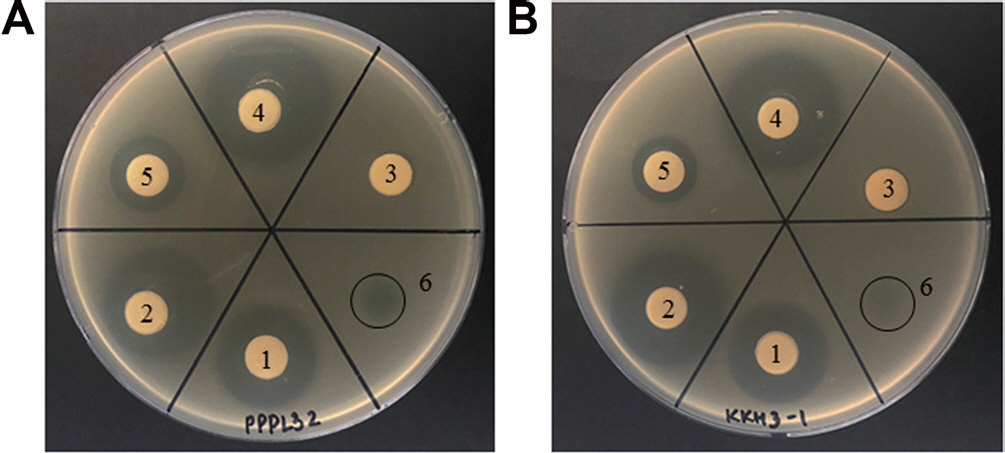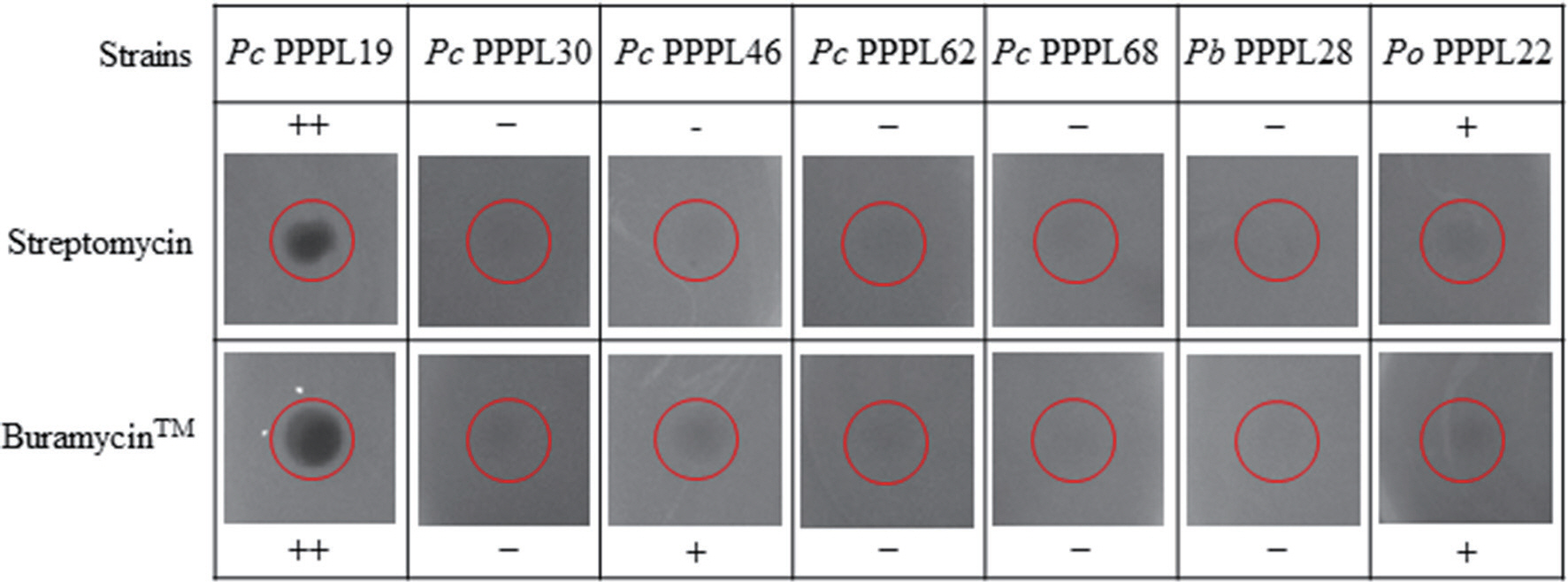Abd-El-Khair, H. and Karima, H. E. H. 2007. Application of some bactericides and bioagents for controlling the soft rot disease in potato. Res. J. Agric. Biol. Sci. 3: 463-473.
Bhat, K. A., Viswanath, H. S., Bhat, N. A. and Wani, T. A. 2017. Bioactivity of various ethanolic plant extracts against Pectobacterium carotovorum subsp. carotovorum causing soft rot of potato tu-bers. Indian Phytopathol. 70: 463-470.
Burr, T. J., Norelli, J. L., Katz, B., Wilcox, W. F. and Hoying, S. A. 1988. Streptomycin resistance of
Pseudomonas syringae pv.
papulans in apple orchards and its association with a conjugative plasmid.
Phytopathology 78: 410-413.

Cooksey, R. C., Morlock, G. P., McQueen, A., Glickman, S. E. and Crawford, J. T. 1996. Characterization of streptomycin resistance mechanisms among
Mycobacterium tuberculosis isolates from patients in New York City.
Antimicrob. Agents Chemother. 40: 1186-1188.




Coyier, D. L. and Covey, R. P. 1975. Tolerance of Erwinia amylovora to streptomycin sulfate in Oregon and Washington [Pears, bacterial diseases]. Plant Dis. Rep. 59: 849-852.
Czajkowski, R., P├®rombelon, M. C. M., van Veen, J. A. and van der Wolf, J. M. 2011. Control of blackleg and tuber soft rot of potato caused by
Pectobacterium and
Dickeya species: a review.
Plant Pathol. 60: 999-1013.

Dees, M. W., Lys├Ėe, E., Rossmann, S., Perminow, J. and Brurberg, M. B. 2017.
Pectobacterium polaris sp. nov., isolated from potato (
Solanum tuberosum).
Int. J. Syst. Evol. Microbiol. 67: 5222-5229.


Glasner, J. D., Marquez-Villavicencio, M., Kim, H.-S., Jahn, C. E., Ma, B., Biehl, B. S. et al. 2008. Niche-specificity and the variable fraction of the
Pectobacterium pan-genome.
Mol. Plant-Microbe Interact. 21: 1549-1560.


Gokul, G. G., Louis, V., Namitha, P. M., Mathew, D., Girija, D., Shylaja, M. R. et al. 2019. Variability of
Pectobacterium carotovorum causing rhizome rot in banana.
Biocatal. Agric. Biotechnol. 17: 60-81.

Han, H. S., Nam, H. Y., Koh, Y. J., Hur, J.-S. and Jung, J. S. 2003. Molecular bases of high-level streptomycin resistance in Pseudomonas marginalis and Pseudomonas syringae pv. actinidiae. J. Microbiol. 41: 16-21.
Jee, S., Choi, J.-G., Lee, Y.-G., Kwon, M., Hwang, I. and Heu, S. 2020. Distribution of
Pectobacterium species isolated in South Korea and comparison of temperature effects on pathogenicity.
Plant Pathol. J. 36: 346-354.




Jones, A. L., Norelli, J. L. and Ehret, G. R. 1991. Detection of streptomycin-resistant
Pseudomonas syringae pv.
papulans in Michigan apple orchards.
Plant Dis. 75: 529-531.

Kang, Y. G., Park, E. K. and Chu, H. G. 1989. Overwintering of tobacco hollow stalk disease pathogen Erwinia carotovora subsp. carotovora in field soils. J. Korean Soc. Tobacco Sci. 11: 41-48. (In Korean)
Kobayashi, K., Haruta, K. and Yoshida, M. 1987. Streptomycin resistance of
Erwinia carotovora subsp.
carotovora isolated from reclaimed Japanese radish fields and natural grassland.
Kyushu Plant Prot. Res. 33: 53-56.

Lee, S., Vu, N.-T., Oh, E.-J., Rahimi-Midani, A., Thi, T.-N., Song, Y.-R. et al. 2021. Biocontrol of soft rot caused by
Pectobacterium odoriferum with bacteriophage phiPccP-1 in kimchi cabbage.
Micro-organisms 9: 779.



Lee, Y. S., Kim, G. H., Song, Y.-R., Oh, C.-S., Koh, Y. J. and Jung, J. S. 2020. Streptomycin resistant isolates of
Pseudomonas syringae pv.
actinidiae in Korea.
Res. Plant Dis. 26: 44-47. (In Korean)


Ma, B., Hibbing, M. E., Kim, H.-S., Reedy, R. M., Yedidia, I., Breuer, J. et al. 2007. Host range and molecular phylogenies of the soft rot enterobacterial genera Pectobacterium and Dickeya. Phytopathology 97: 1150-1163.
McManus, P. S., Stockwell, V. O., Sundin, G. W. and Jones, A. L. 2002. Antibiotic use in plant agriculture.
Annu. Rev. Phytopathol. 40: 443-465.


Miller, T. D. and Schroth, M. N. 1972. Monitoring the epiphytic population of
Erwinia amylovora on pear with a selective medium.
Phytopathology 62: 1175-1182.

Minsavage, G. V., Canteros, B. I. and Stall, R. E. 1990. Plasmid-mediated resistance to streptomycin in Xanthomonas campestris pv. vesicatoria. Phytopathology 80: 719-723.
Nguyen, H. T., Yu, N. H., Park, A. R., Park, H. W., Kim, I. S. and Kim, J.-C. 2017. Antibacterial activity of pharbitin, isolated from the seeds of
Pharbitis nil, against various plant pathogenic bacteria.
J. Microbiol. Biotechnol. 27: 1763-1772.


Russo, N. L., Burr, T. J., Breth, D. I. and Aldwinckle, H. S. 2008. Isolation of streptomycin-resistant isolates of
Erwinia amylovora in New York.
Plant Dis. 92: 714-718.


Sang, M. K., Dutta, S. and Park, K. 2015. Influence of commercial antibiotics on biocontrol of soft rot and plant growth promotion in Chinese cabbages by
Bacillus vallismortis EXTN-1 and BS07M.
Res. Plant Dis. 21: 255-260.

Shrestha, A., Kim, E. C., Lim, C. K., Cho, S., Hur, J. H. and Park, D. H. 2009. Biological control of soft rot on Chinese cabbage using beneficial bacterial agents in greenhouse and field. Korean J. Pestic. Sci. 13: 325-331.
Sundin, G. W. and Bender, C. L. 1993. Ecological and genetic analysis of copper and streptomycin resistance in Pseudomonas syringae pv. syringae. Appl. Environ. Microbiol. 59: 1018-1024.
Xu, Y., Zhu, X.-F., Zhou, M.-G., Kuang, J., Zhang, Y., Shang, Y. et al. 2010. Status of streptomycin resistance development in Xanthomonas oryzae pv. oryzae and Xanthomonas oryzae pv. oryzi-cola in China and their resistance characters. J. Phytopathol. 158: 601-608.
Yongsheng, H., Xiaojun, L., Shijin, Z., Yongsheng, M. and Li, W. 2014. Field efficiency trial of 72% streptomycin against Konjac bacterial soft rot. Plant Dis. Pests 5: 29.
Young, J. M. 1977. Resistance to streptomycin in
Pseudomonas syringae from apricot.
N. Z. J. Agric. Res. 20: 249-251.







 PDF Links
PDF Links PubReader
PubReader ePub Link
ePub Link Full text via DOI
Full text via DOI Download Citation
Download Citation Print
Print






